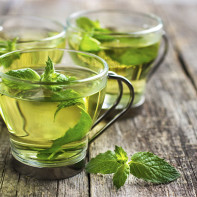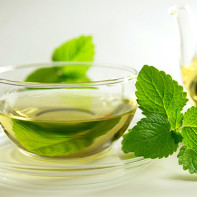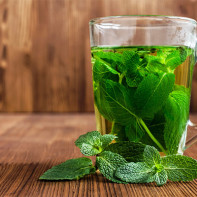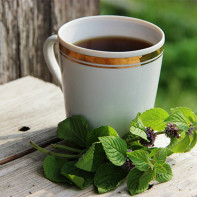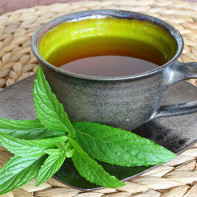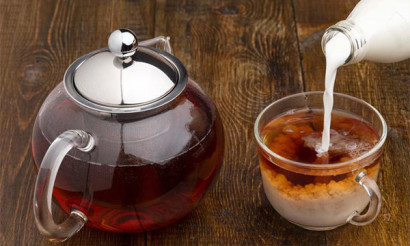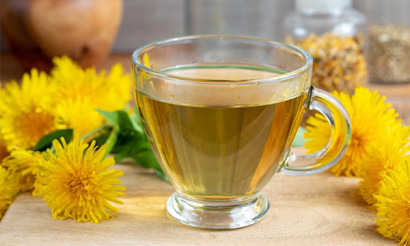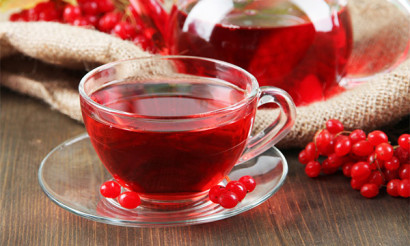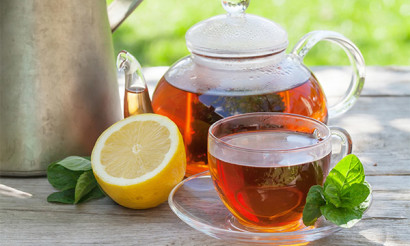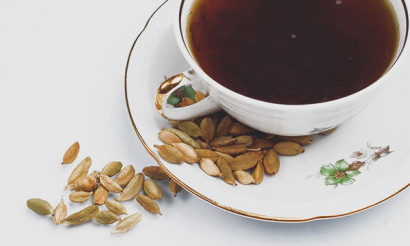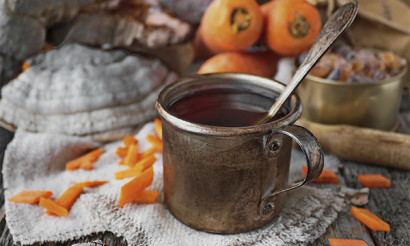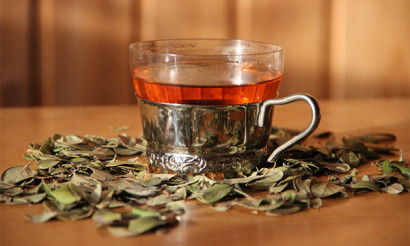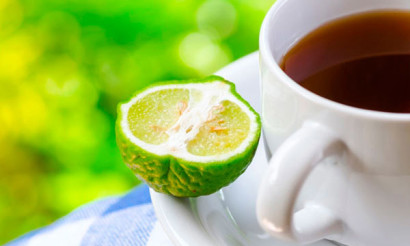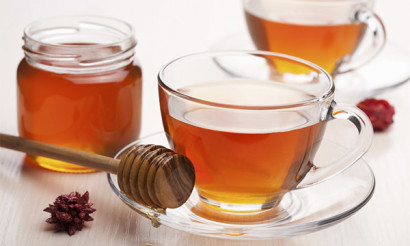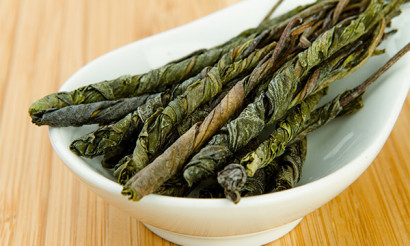Peppermint tea: useful properties and contraindications
Among all medicinal plants, mint rightfully occupies a place of honor. Hundreds of years ago, people learned about the healing capabilities of this plant, and to this day mint enjoys unprecedented popularity. Tea is used to treat and prevent many diseases, it is loved all over the world for its unusual aroma and fresh taste.
- Composition and calories
- What is useful for tea with mint
- General benefits
- For Women
- For Men
- When pregnant
- For breastfeeding
- For children
- When losing weight
- Peppermint tea in medicine
- Diabetes mellitus
- For pancreatitis
- For gastritis
- For colds
- When hungover
- At poisoning
- For hypertension
- For varicose veins
- Sleeplessness
- Harms and Contraindications
- How to Dry Mint for Tea
- How to freeze mint for winter tea
- Can I drink peppermint tea every day?
- Can I drink it every night?
- How to brew peppermint tea correctly: Recipes
- Classic recipe
- With lemon
- With Ginger
- With Honey
- With cinnamon
- With milk
- With raspberry
- With melissa
- Thyme
- Oregano
- With chamomile
- Moroccan Tea with Mint
- Interesting Facts about Mint
Composition and calories
The composition of ordinary mint tea, consisting of water and leaves of the plant, contains only 1 kcal, unlike drinks in which lemon and sugar are added. In sweet tea, the caloric content is much higher - from 7.4 to 30 per 100 ml, depending on the amount of sugar in the composition. The nutritional value of the tea is expressed in carbohydrates, which amount to 1.7 g per 100 ml of the finished product.
What makes mint tea truly unique is its extensive chemical composition, represented by a whole list of useful acids and trace elements:
- ascorbic acid;
- menthol;
- thiamine;
- phytoncides;
- saturated fatty acids.
What is the usefulness of peppermint tea
General benefits
Peppermint tea can be an excellent assistant in the fight against many ailments. The main thing is to know the measure and do not forget about contraindications. All the useful substances contained in this healing plant make mint a real queen among medicinal herbs. This fragrant, tasty tea is a treasure trove of nutrients that affect almost all systems of the human body:
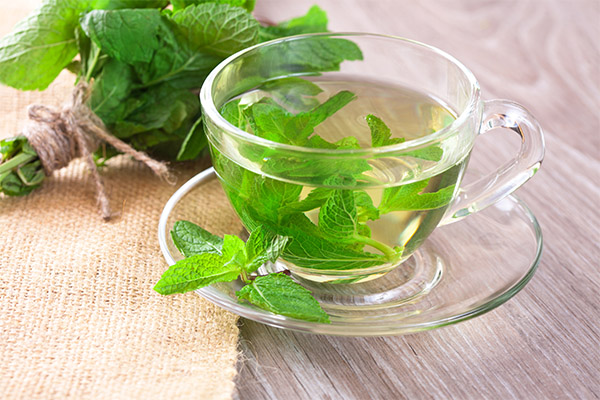
- Tea has a pronounced sedative effect. It has the ability to gently relax the body and give a sense of calm after a hard day.
- Tea is invaluable in the treatment and prevention of colds. Freshly brewed tea can not only reduce the fever, but also improve the overall condition of the sick person.
- In combination with medicines, tea from the medicinal plant will help to eliminate the pronounced symptoms of acute respiratory diseases. It can improve the discharge of phlegm from the lungs and relieve runny nose. It is recommended to drink tea for preventive purposes to strengthen the immune system.
- Fragrant tea is considered an excellent aid in alleviating headaches in women. In addition, it can regulate the menstrual cycle.
- Normalization of blood pressure is also the merit of mint tea. In addition, it normalizes blood circulation, alleviates heart disease and helps from excruciating cramps during migraine attacks.
- The good news for those who are struggling with obesity: the fragrant drink can speed up metabolism and can be a great addition to the diet.
- Tea has a pronounced antibacterial effect not only when taken orally, but also as a compress. Freshly brewed infusion helps relieve skin inflammation and soothes itching.
- Freshly brewed mint tea can also help with stomach pain.
- The drink helps reduce stomach cramps, balance the bile balance, and fight excessive gas and bowel discomfort.
- Peppermint tea can be an excellent aid in normalizing sleep, eliminating anxiety, improving brain activity.
For women
Peppermint has a truly amazing effect on the body of women. It is recommended to resort to the use of tea when hormone levels fluctuate and malaise in the premenstrual period. Peppermint has a beneficial effect on the skin, participating in cell regeneration. It is recommended to use peppermint tea to alleviate the symptoms of menopause. The drink will also help with problems related to inflammation in the pelvic organs and increased growth of body hair.
For men
Men are not advised to abuse peppermint-based tea. Unfortunately, it has a negative effect on their body, reducing the level of testosterone, thereby reducing potency and nullifying the sex drive. However, mint is not contraindicated for the male body and you should use it as a treatment during the periods of illness as a weekly course, and it is also recommended to drink it before going to sleep in case of insomnia and excessive tension.
When pregnant
There is still no clear answer as to whether or not mint can be consumed by pregnant women. Some obstetricians and gynecologists are of the opinion that mint tea can tone the uterine muscles, prevent heartburn, eliminate dizziness and constipation, reduce swelling, and strengthen the immune system. Also, pregnant women are recommended the healthy warming drink as an alternative to the unwanted use of antibiotics. However, some doctors are of the opinion that peppermint can cause harm to women in the position. Some of the undesirable reactions include allergies, severe heartburn, especially at the end of pregnancy, and decreased blood pressure in people with hypertension. Some obstetricians and gynecologists claim that the increased tone of uterine muscles, provoked by excessive consumption of mint tea, can even lead to miscarriage.
Tea is useful for a woman, so after the baby is born, doctors recommend adhering to the recommendations and drinking a mug of drink no more than 2-3 times a week. Women who have had a difficult pregnancy and childbirth with complications should consult a gynecologist.
When breastfeeding
In order not to harm lactation, breastfeeding mothers can drink mint tea in a limited amount. Menthol, found in peppermint, in excessive amounts threatens to disrupt lactation. This is why certain varieties are recommended for breastfeeding women: Melissa (lemon peppermint) and peppermint. These varieties do not interfere with the production of breast milk, and can protect a nursing mother from postpartum depression. In the first month of life, it is advised with caution to consume products with mint, as there is a possibility of the baby having colic.
For children
A pronounced sedative effect of mint can have an adverse effect on the body of young children, so doctors do not advise to introduce mint tea into the child's diet before the age of three. However, on the shelves you can see children's herbal teas, which include mint. Before you buy such a product, you should discuss it with your pediatrician. For children over the age of three, it is advised to brew a weak tea, adding just one sprig of mint to it.
For weight loss
Mint is famous for its ability to speed up metabolism and eliminate toxins from the body. That is why there are many techniques, according to which mint in the diet of a slimming person should accelerate his fight against extra pounds. Particularly popular are unloading days on mint tea. Their essence is that a person can drink only mint tea up to one and a half liters during the day. The authors of such a diet promise a loss of up to 1 kg a day by eliminating excess fluid and normalizing digestion.
Peppermint tea in medicine
In every pharmacy, among the variety of gatherings with medicinal herbs, you can see a whole shelf of packages with dried mint leaves for tea. Doctors recommend the use of peppermint tea in conjunction with medications and as an alternative to many drugs. Therapists advise brewing tea for colds and for prevention during the cold season, cardiologists - to use along with prescribed medications to combat angina, tachycardia, arterial hypertension. Doctors recommend tea for people suffering from myalgia, neuralgia, rheumatism and radiculitis. The tea has moderate sedative, carminative, analgesic, and antiseptic effects. Doctors in many practices find it useful to include the use of peppermint tea in the treatment of patients.
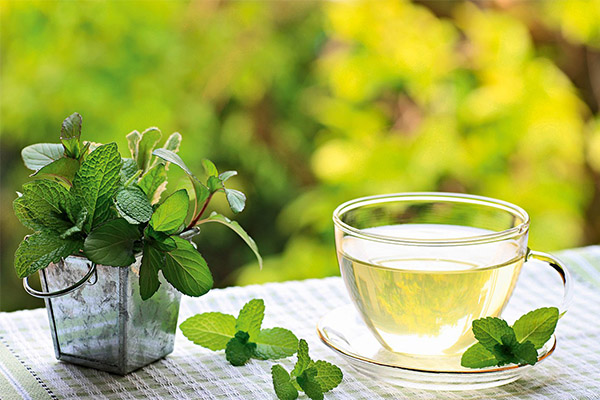
In Diabetes Mellitus.
Peppermint leaves as a tea can help people with diabetes. Menthol can lower blood glucose levels, but the important thing is not to overdo it, as peppermint tea can be poorly compatible with medications prescribed to the patient. People suffering from this disease are advised to consume up to three cups of tea a day for several weeks for maximum effect, and then take a short break.
For pancreatitis
Thanks to the constituent biologically active components of mint, tea can be a real salvation in the fight against pancreatitis. It can greatly increase the effect of taking unnatural medications. In the chronic course of the disease tea from the fragrant plant will help reduce exacerbations and smooth the adverse effects of drugs. To prepare a useful tea, 10 g of dried leaves should be poured over boiling water, infused and used without sugar for half a glass 3 times a day.
With gastritis
Gastroenterologists advise mint tea for inflammatory gastritis. Cooked from dried leaves, the drink is able to relieve pain, bloating and cramps. Fresh mint leaves as part of the tea can activate secretory activity, neutralize nausea and relieve discomfort. The secret of the healing tea is that it is an excellent antiseptic and has an effect on the mucosa of the stomach, while its antispasmodic properties affect the smooth muscles of the stomach. A useful decoction is prepared from 50 g of fresh or 5 g of dried leaves by pouring boiling water and soaking under a lid for a quarter of an hour.
Colds
With a whole bouquet of beneficial trace elements, mint can alleviate the symptoms of colds and speed recovery. Use mint in a tea as a collection with other medicinal herbs, as well as separately. It is necessary to drink mint tea several times a day, adding lemon and honey, and the disease will soon recede.
A hangover
After a noisy feast with alcohol, the morning may feel terrible malaise, but if you have peppermint in your medicine cabinet, it can be easily overcome. To alleviate the symptoms of a hangover, such as nausea and headache, it is advised to prepare peppermint tea from leaves collected by yourself or bought in the pharmacy in the form of filter packs. Prepare such tea according to the already known recipe - just pour boiling water and allow to infuse. For a greater effect, it is recommended to add honey.
When poisoned
Symptoms of poisoning can be in some ways similar to the symptoms of a hangover, but it is important to remember that in this condition, many products are prohibited for consumption. Fortunately, peppermint tea is not one of them. To stop vomiting and relieve the painful symptoms, mint tea can help. It is advised to mix in equal amounts of mint, oregano and St. John's wort and pour a spoonful of this mixture with boiling water. Soon the discomfort caused by poisoning should recede.
For hypertension
For people suffering from hypertension, mint tea can become a real "green doctor". Vasodilators from the pharmacy, such as Valokordin and Validol, contain menthol. It is the menthol in peppermint that can lower high blood pressure. Blood begins to circulate better through the vessels, the vascular lumen expands, and all thanks to the fact that menthol reduces the blood pressure. Mint tea, which contains menthol, is able to reduce high blood pressure, relieve headaches. It also normalizes heart rhythm and helps with heart disease associated with hypertension, such as angina and tachycardia.
In addition, peppermint tea is able to normalize a rapid pulse. Those who have ruled out all possible contraindications should prepare tea using dried or fresh leaves poured with a glass of boiling water. For the treatment and prevention of heart disease and hypertension, it is recommended to drink half a glass of tea at night.
With varicose veins.
Peppermint has diuretic properties, which helps it easily remove excess fluid from the body. This may attract the attention of those who suffer from varicose veins, but mint tea is not recommended to use in this disease. Tea based on peppermint has a vasodilator property, which may lead to increased pain and the appearance of venous nodules. Therefore, people who suffer from such a disease in a severe form, before taking a drink, it is necessary to consult a specialist.
From insomnia
There is still a lot of debate about the benefits of peppermint tea for insomnia. Some claim that the herb, which has sedative properties, can have a beneficial effect on sleep. Some doctors are of a different opinion and believe that menthol can keep you awake. This is due to its ability to affect the contraction of the muscular ring of the esophagus. Menthol does not allow it to close, provoking morning heartburn. Specialists advise to consider other useful teas for consumption at night.
Harms and contraindications
No matter how tasty and useful tea is, it has properties that can harm some categories of people. Exclude peppermint tea from their diet is necessary for people with hypersensitivity to certain components of mint. As it has already been found out, these include pregnant women, children, people suffering from varicose veins and low blood pressure.
When the tone of the blood vessels is reduced, mint can lead to an exacerbation of some other chronic disease. Do not recommend to abuse peppermint tea for people who suffer from heartburn, because it can aggravate the situation.
Another serious contraindication is infertility. People who have problems with conception are not recommended to include peppermint tea in their diet. With caution, men and people who suffer from drowsiness should consume the tea.
How to dry peppermint for tea
The essential oil, which contains menthol, gives peppermint an extraordinary flavor and aroma. This is the type of mint most often harvested for tea. It is commonly planted in plots around the country house, in extensive plantations, and even on a window sill. To preserve the amazing aroma, gardeners advise to harvest responsibly and cut mint whole branches using pruning shears.
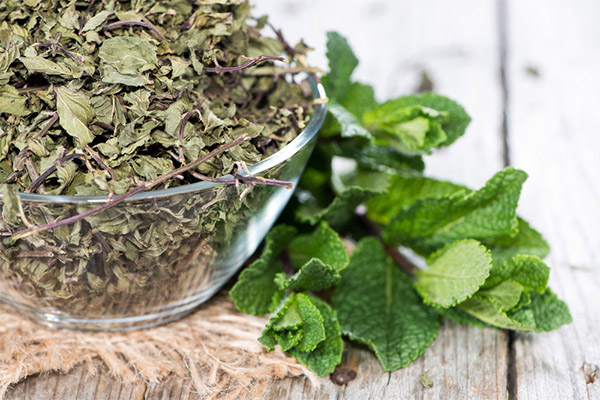
Peppermint is harvested in late summer, which is when the leaves become juicy and fragrant. A little too late and dark spots will appear on the plant's leaves and the stems will become coarse. Harvest the leaves when it is warm and dry so that they will remain green after drying, and water the day before to wash off the dust and let them dry before harvesting.
It is believed that after 5 years of life mint bushes is better to uproot, the leaves on such a plant are no longer able to give the famous taste and aroma of tea. Freshly harvested leaves should be immediately shielded from direct sunlight, they can worsen the quality of the tea. The drying of the plant must be done responsibly: the leaves must be clean and dry. Only in this case there is no chance of mold formation on the material.
The conservative method is drying in the fresh air. Perhaps this method is the most reliable, because using various kitchen devices can inadvertently exceed the temperature and nullify all the benefits.
For outdoor drying, prepare bundles consisting of 10-15 sprigs of mint. The main thing is not to overextend the bundle, so as not to block the access of air to the stems inside. The ready bundles are hung up with the leaves down in a room with good ventilation. A balcony, veranda or loggia will do for these needs. The billets should be turned from time to time. The leaves can be dried on a horizontal metal or wooden surface covered with dry, clean paper or a cloth. The main thing is to remember to turn the dried plant a couple of times a week.
At a temperature of 20-30 degrees the plant will dry for two weeks. During this time, the mint should be shielded from the sun, dust and foreign odors. The finished leaves will crisp and crumble when squeezed.
Modern housewives have long adopted various kitchen gadgets that can help in making mint for tea. In an electric dryer, it is possible to prepare mint in 3-4 hours by drying it on trays at a temperature of 30 degrees or more. In a microwave oven, it is enough to dry the leaves several times for 10 seconds, checking the readiness of the raw material by touch. For the oven will be enough for only 40-50 minutes to get ready for tea. The tray is covered with parchment paper, on which the leaves are laid and dried at a temperature of 60 to 90 degrees. It is desirable to select leaves of equal size to ensure even drying.
It is recommended to store dried mint in whole leaves or crushed into a powder. For storage, it is preferable to choose bags made of natural fabric, linen or cotton. But vacuum bags, tightly closed wooden and ceramic containers will do. It is necessary to indicate the date of packing on the package and put it in a dark cool place, remembering to check the mint occasionally for mold. Mint tea can be stored for up to 2 years if all the rules are followed.
Proper storage will ensure that the tea has an extraordinary flavor and aroma.
How to freeze mint for tea in winter
It turns out that in addition to drying, mint can also be harvested in frozen form. There are several ways to do this.
- Whole leaves. Mint bought or picked on the windowsill is kept in cold water for a few minutes, and then dried on a towel. Dry clean leaves are put in a glass jar, tightly covered with a lid and sent to the freezer. The same way you can freeze whole sprigs, the main thing - do not use plastic bags for storage, in which the mint can be damaged in the process of freezing.
- In ice cubes. Silicone and plastic ice molds can be used for this method. The leaves and stem tops are washed and gently placed in the molds, then poured over with cold boiling water. This method will prevent the leaves from crumbling as they are stored in the freezer. After freezing, the mint cubes are packed into bags and put back into the freezer.
- Freezing mint pulp. This method is similar to the previous one, mint also needs to be frozen in molds. However, before this, it must be crushed in the bowl of a blender with the addition of water. After the pulp is sent in molds in the freezer, and after freezing it is packed in bags.
To make a warming tea in winter, you can add a frozen twig or ice cube to a mug and enjoy a fragrant drink.
Can I Drink Peppermint Tea Every Day
Drinking a cup of tea every day can solve problems with high blood pressure, problematic skin, and headaches. Some studies claim that drinking tea every day after a meal can relieve stress and help you calm down and relax.
Drinking tea at night
Drinking tea before bedtime is still not recommended, it is fraught with morning heartburn and excessive sedative effect for people prone to sleepiness. The optimal mode of reception of peppermint tea - a couple of times a week in the absence of contraindications.
How to brew peppermint tea correctly: recipes
To preserve its healing properties and increase the flavor qualities, it is necessary to adhere to certain recommendations when brewing this unique tea. The most suitable teapot for tea is rightly considered a glass or ceramic. It is not advised to pour boiling water into this teapot, you should give water time to cool down to 80 degrees. The best ratio of water and mint leaves - 1:1, ie, one glass of water to add 1 tsp of brew and the same amount of mint leaves.
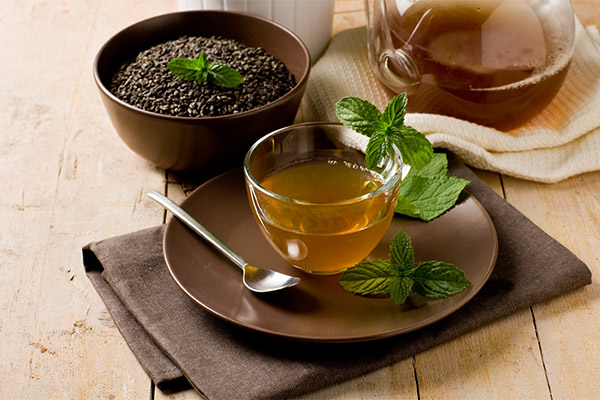
A classic recipe
To make it you will need 400 ml of water, 3 small sprigs of mint and 2 tsp. green tea. Pour the ingredients into a kettle, add boiling water and infuse for 2-3 minutes. You can substitute any tea with black or red tea, but the most organic is still considered Chinese green tea, which has a neutral flavor.
With lemon
This tea has an excellent tonic effect, invigorating and improving mood. To make it, crush fresh mint (one-third teaspoon). Mint pour boiling water, infuse and then strain. Pour the tea into a thermos, add lemon juice and drink in small portions. This is an indispensable recipe for colds.
With ginger
Ginger is not inferior to mint in the number of useful trace elements in its composition. Together with mint, they can alleviate many diseases. To prepare a useful drink, you will need 3 grams of mint and the same amount of grated ginger. Infuse the mixture with boiling water and infuse it for a few minutes. You can add honey for prevention and treatment of colds, and lovers of tart tea can add tea brew to taste.
With honey
Peppermint and honey are great both cold and hot. In summer, brewed and chilled mint with honey can be perfectly refreshing, and in winter, it can protect the immune system from the onslaught of colds and viruses. It is equally delicious to drink mint tea with honey in a snack.
With cinnamon
Beautiful drink with oriental notes will leave few people indifferent. For its preparation is recommended to pour fresh mint in boiling water and add a couple of cinnamon sticks. You can add orange zest, clove sprigs or ginger to this wonderfully warming drink. For lovers of tart teas, it is advised to use a brew of black or green tea.
With milk
This tea has a refined taste and exquisite aroma. To make it, you need to boil water with black tea and 1 tsp. chopped mint, then add 400 ml of milk, sugar and lemon juice to taste. This tea is revered among many gourmets, and some people can even replace breakfast.
With raspberries
This kind of tea boasts a high content of organic acids, antioxidants and vitamins. Tea with mint and raspberries is an excellent anti-inflammatory, a gift from nature. To make tea you will need to grind the leaves of raspberries and mint, pour into a thermos 1 tsp. pour 250 ml of boiled water, cooled to 80 degrees. After 10-15 minutes the tea will be brewed and ready to use.
With lemon balm
Melissa is of the same species as peppermint, but they are easily distinguished by their scent. Peppermint has a pronounced menthol smell, while the smell of melissa is calmer and sweeter, with citrus notes. If you make tea with dried leaves of mint and lemon balm, you can get a great remedy with high antioxidant content and an unusual taste.
Thyme
Tea with thyme and mint combines all the most beneficial properties of these two plants. The thyme contained in this tea, has unique antifungal and antiseptic properties, thus is an indispensable aid in getting rid of many health problems. To make a healing tea you need 1 tsp. mixture of dried mint and thyme pour 200 ml. water, insist for 10 minutes and strain.
With oregano
These 2 plants combine perfectly in taste and can help with many ailments such as sleep disorders, headaches, increased fatigue. Oregano and mint are mixed in equal amounts and infused with 0.5 tbsp. 250 ml of boiling water. Influence the tea for 5 minutes.
With chamomile
This tea is an excellent antispasmodic and a first aid in treating colds. The combination of mint and chamomile improves sleep, helps to cope with stress and calms. To make it 1 tsp. mint and 1 tsp. chamomile pour a glass of boiling water and leave to infuse for 15 minutes. For more benefit, you can add honey.
Moroccan Peppermint Tea
An amazing recipe straight from Morocco will surprise any tea lover with its unusual flavors. The classic recipe uses only green Chinese tea and mint. Pour 2 tsp. of tea into a kettle and fill it with 500 ml of boiling water. The tea should infuse for 15 minutes, then it is poured into a small saucepan, added sugar and brought to a boil over medium heat. Just before it comes to a boil, mint leaves are added. The secret of the tea is its foam, which is why it must be poured into cups from a height of at least half a meter. For a spectacular serving, it is recommended to serve the drink in a transparent container, this will help you see the foam and mint leaves.
Interesting facts about mint

- The name of the plant comes from ancient Greece, where, according to legend, the jealous wife of Hades, the god of the kingdom of the dead, separated him from his new beloved. The beautiful girl's name was Minta; Persephora, Hades' wife, turned her into an unremarkable plant. Hades, tormented by the separation from his beloved, was never able to return her to her human form, but he gave the unattractive shrub an amazing fragrance. This story seemed to the beautiful Aphrodite very romantic, and mint became her favorite plant, it began to be used as an aphrodisiac.
- In the Ancient Roman Empire, women used mint as perfume and put sprigs in pillows, believing that its scent could improve sleep and ward off bad dreams.
- The ancient Romans wiped tables with an infusion of mint and sprinkled mint water indoors for the sake of a refined odor in the dwelling.
- In ancient Egypt, mint was used in the preparation of sweets, and pharaohs were sent to their last journey with bundles of the plant in their tombs.
- The amazing properties of mint found its application not only in medicine and cooking. Its essential oil is considered one of the most popular in the world. Mint notes are able to repel mosquitoes, and some claim that even mice are afraid of this smell.
- It is said that mint seen in a dream promises a cheerful life. Another superstition advises putting a mint leaf in your wallet to keep money in it.
- The same family as mint includes a bunch of other popular aromatic plants: oregano, basil, valerian, rosemary.
- Housewives recommend mint as an excellent preservative for milk, with which it won't sour for long. However, you need to be prepared for the milk to take on a minty flavor.
- Peppermint, the most popular of its kind, was obtained by crossing two species: water mint and spiked mint.
- There are two islands in Japan where the special mint grows. It can only be found in the rippling marshes, it is actively used in cooking and cosmetology, and it is quite expensive.
- Before the invention of all kinds of toothpastes, Hippocrates recommended rinsing your mouth with mint infusion to whiten your teeth and kill germs.
- Peppermint is quite a powerful allergen, so it should be kept away from people with allergies.
- Mint is actively used in cooking, it is advised as a sauce to meat, some prefer to add it to coffee.
- Catnip is three completely different plants that cats like very much.
- In all, there are about 300 species of catnip known in the world, and it grows and is cultivated in almost every country.
- In ancient times, mint was even used to infuse wine, and the Italians and South Americans used it to make refreshments.
- The Assyrians were the first to use mint as a medicine.
- People all over the world use mint as a proven remedy for headaches, nausea, and intestinal ailments. It is not advised to completely replace medicines, but only to use it as an adjunct in the treatment of a number of diseases.
«Important: All information on the site is provided solely for introductory purposes only. Before applying any recommendations, please consult with a specialized specialist before using one of the recommendations. Neither the editors nor the authors shall be liable for any possible harm caused by materials."

